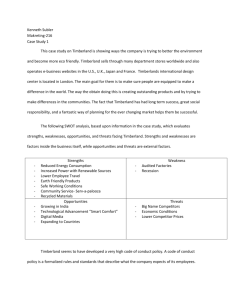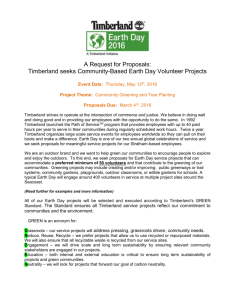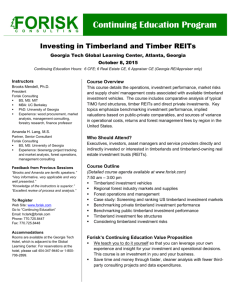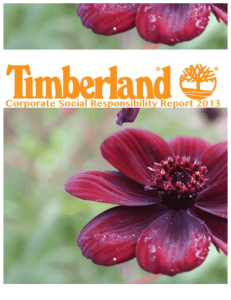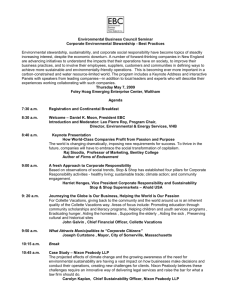Document 10542374
advertisement
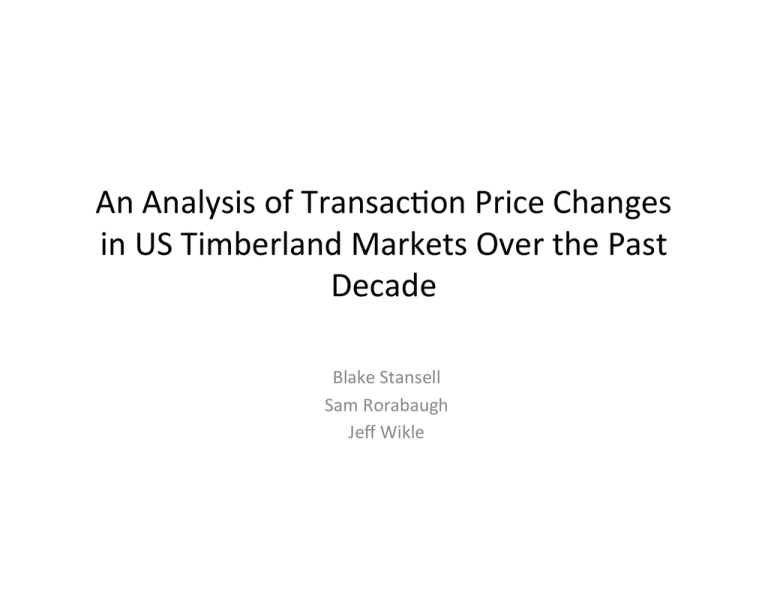
An Analysis of Transac.on Price Changes in US Timberland Markets Over the Past Decade Blake Stansell Sam Rorabaugh Jeff Wikle Purposes • To review price changes in the US .mberland market over the last ten years. • Analyze any notable price trends in specific regions with a focus on the eastern US. Descrip.on of the US Timberland Marketplace Over the Past Decade 2002 – 2011 • Approximately 32 million acres and more than $36 billion of transac.ons. • Only one year in the last decade with less than $1 billion of large .mberland transac.ons—2010. • The peak years for volume and price were from 2006 to 2008 when an average of over 5 million acres and $7 billion per year were transacted. • Transac.on size has trended down in recent years: in 2010, the number of transac.ons was greater than in 2007, but the total value of transac.ons in 2010 was only 1/10th of the value traded in 2007. • For the en.re decade: – More than 1/2 of the traded acres were in the South and involved primarily pine planta.on – About 1/3 were northern transac.ons (mostly hardwood and natural soZwood) – The remaining deals were in the Pacific Northwest. • The 2011 average price per acre is down more than 50% from the 2007 peak. Why? We will a_empt to address this ques.on in our presenta.on. Large Timberland Acres Sold and Average Price per Acre US: 2002 – 2011 8,000 $1,800 7,000 $1,600 $1,400 5,000 $1,200 4,000 $1,000 3,000 $800 2,000 $600 1,000 $400 2002 2003 2004 2005 2006 US Large Tract Acres Traded 2007 2008 2009 2010 US Large Timberland $/acre 2011 Price Per Acre Acres (thousands) 6,000 Large Timberland Transac.on Prices by Region: 2002, 2007, and 2011 $3,250 $3,000 $2,750 $2,500 $ per Acre $2,250 $2,000 $1,750 $1,500 $1,250 $1,000 $750 $500 $250 $-­‐ 2002 2007 North South Pacific Northwest 2011 Large Timberland Acres Traded by Region: 2002 – 2011 The Mix has Changed 8,000 7,000 Acres (thousands) 6,000 5,000 4,000 3,000 2,000 1,000 -­‐ 2002 2003 2004 2005 North 2006 South 2007 2008 Pacific Northwest 2009 2010 2011 Eastern US Timber and Timberland Market Trends: North vs. South • The average price per acre for southern transac.ons is up about 60% over the past decade, while the average for northern transac.ons is up only modestly (2%). • Volume has shiZed over .me to include more northern transac.ons. • Saw.mber prices have trended down, but at a significantly different pace in the two regions: – TMS Southwide Pine Saw.mber Index cumula.ve drop: 34%. – TFG Hardwood Saw.mber Index cumula.ve drop: 3%. • Pulpwood prices (especially for hardwood) have increased substan.ally in both northern and southern .mber regions: – TMS Southwide Hardwood Pulpwood Index cumula.ve increase: 27%. – TMN Wisconsin Statewide Hardwood Pulpwood price has more than doubled in the past decade. Regional Timberland Acres Sold and Average Price per Acre Northern and Southern US: 2002 – 2011 $1,800 6,000 5,500 $1,600 5,000 Acres (thousands) 4,000 $1,200 3,500 $1,000 3,000 $800 2,500 $600 2,000 1,500 $400 1,000 $200 500 $0 2002 2003 2004 2005 Southern US Large Tract Acres Traded Southern US $/acre 2006 2007 2008 2009 2010 2011 Northern US Large Tract Acres Traded Northern US $/acre Price Per Acre $1,400 4,500 Timber Markets: 2002 to 2011 250 225 Index Value 200 175 150 125 100 75 50 TMS Pine ST TMS Pine Pulpwood TFG Index HW ST TMN-WI Pulpwood TMS HW Pulpwood Price Trends: Southern Timberland, Southeast Timberland Dirt, Farmland, and Pine Saw.mber 2002 to 2011 350 325 300 275 250 225 200 175 150 125 100 75 50 2001 2002 2003 2004 Southeast Timberland Price per Acre South-­‐wide Pine Saw.mber 2005 2006 2007 2008 2009 2010 NCREIF Southeast Farmland Apprecia.on Return Southeast Timberland Dirt Value 2011 Why Have Timberland Transac.on Prices and Saw.mber Prices Moved in Opposite Direc.ons? Poten9al Explana9ons: 1. 2. 3. 4. 5. Land values for large .mberland proper.es in the South have increased substan.ally over the past decade as alterna.ve land-­‐use values have increased: primarily farmland and recrea.onal .mberland. The same has not occurred in most northern .mberland areas where fewer alterna.ve land uses exist. Capital flowing (measured by transac.on volume) into southern .mberland increased substan.ally in 2006 and 2007 and has since dropped significantly through 2011. Timberland prices have been s.cky, contrac.ng only modestly as capital flow dropped—reflec.ng reluctance of landowners to reduce their asking prices. Only deals on the margin (i.e. the most aggressive buyers and most anxious sellers) have been gekng consummated. Discount rates were compressed as more capital was available to pursue fewer .mberland opportuni.es. Also, interest rates in general have declined. Increased interest in woody biomass as an energy source has resulted in an up.ck in pulpwood prices in both the southern and northern regions. Expecta.ons of improved yields? Capital Flow and Average Price per Acre for Large US South Timberland 2002 -­‐ 2011 8,000 $1,800 7,000 $1,600 $1,400 6,000 $1,200 5,000 $1,000 4,000 3,000 $600 2,000 $400 1,000 $200 $0 -­‐ 2002 2003 2004 Capital Flows 2005 2006 2007 2008 2009 2010 US South Large Timberland $/acre 2011 $/Acre Million $ $800 Timberland Pricing Sensi.vity Analysis Lower Hurdle Rates Can Explain Pricing Gains Base Case Scenario A Scenario B Scenario C Real Hurdle Rate 7.0% 6.0% 6.0% 5.0% Real Timber Pricing Outlook 1.0% 1.0% 0.5% 0.0% 20.0% 9.1% 20.0% Timberland Value Change Note: Presumes a fully regulated southern pine forest without HBU attributes. Assumes everything else the same. Price Trends: Northern Timberland, Northern Timberland Dirt, and Hardwood Saw.mber 2002 to 2011 200 175 150 125 100 75 50 25 -­‐ 2001 2002 2003 2004 Northern Timberland Price per Acre 2005 2006 2007 2008 Northern Timberland Dirt Value 2009 2010 TFG HWD Index 2011 Timberland Price Indicators: North vs. South 2002 – 2011 8.0 7.0 6.0 Ratio 5.0 4.0 3.0 2.0 1.0 02 03 04 05 06 Southern Timberland $/acre to Timber Mart South Pine ST 07 08 09 10 11 Northern Timberland $/acre to TFG Hardwood ST Why No Run-­‐up in Northern Timberland Values? • Some states have regula.ons that restrict subdivision and/or clearcukng: Maine, Upstate New York Adirondack Park. • Amount of acres which are feasibly conver.ble to non-­‐.mber uses— especially agricultural land—is much smaller in the North: e.g., topography in Appalachia, environmental regula.ons in Northeast. • In pockets of the Northern region where compe.ng land uses are more prevalent than others (such as recrea.onal usage) the increase in land values have been similar to those in the South, but the volume of recrea.onal transac.ons is down significantly. • Stumpage markets have been mixed across the North: Appalachian Oak versus Michigan Hard Maple versus Pennsylvania Black Cherry. Conclusions • Increase in the value of farmland in the South likely contributed to the run up in southern .mberland values over the past decade. • Northern .mberland prices have increased, but the change has been less drama.c and dirt has remained a smaller por.on of overall .mberland value. Limited conversion poten.al and a less robust recrea.on market probably explain this phenomenon. • In the South, land value changes do not fully explain the magnitude of the increase in transac.on prices in the face of falling .mber prices. Other factors include discount rate decreases and, to a lesser degree, pulpwood price increases. • Further empirical research is needed: a detailed assessment/ decomposi.on of individual transac.ons from different .me periods, in specific loca.ons to be_er quan.fy the value change drivers.
